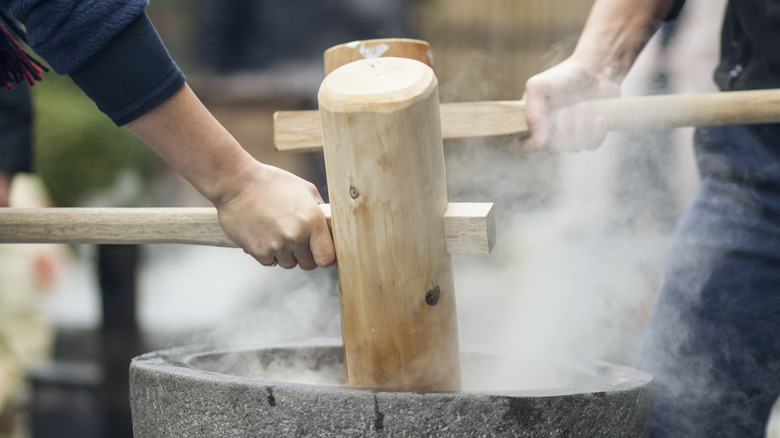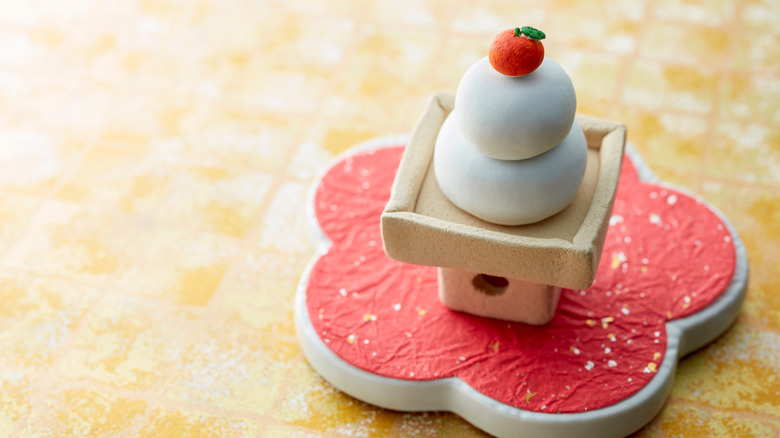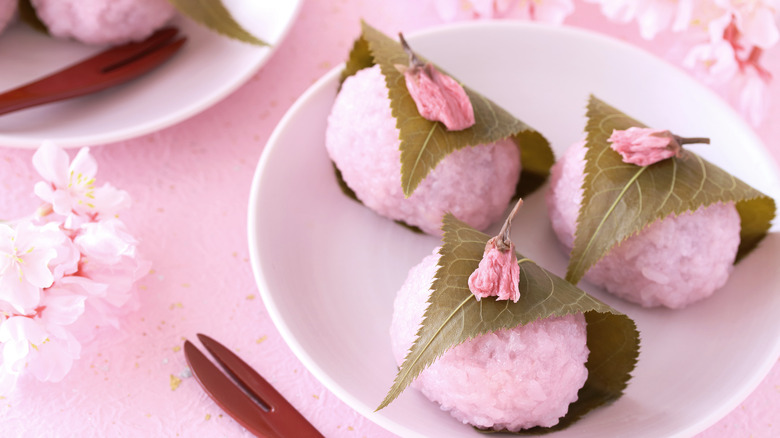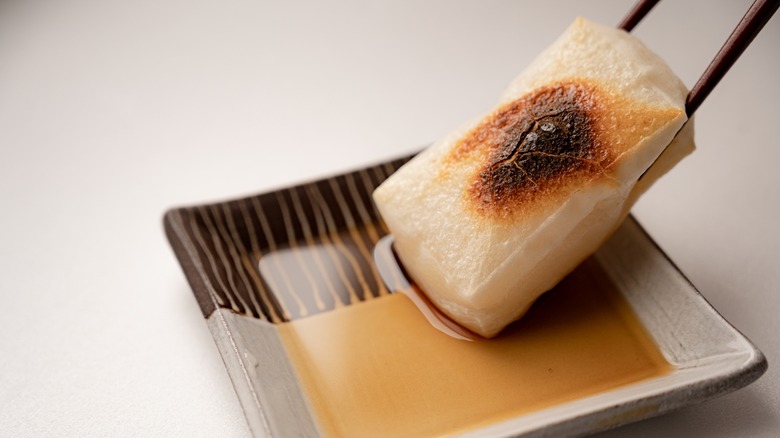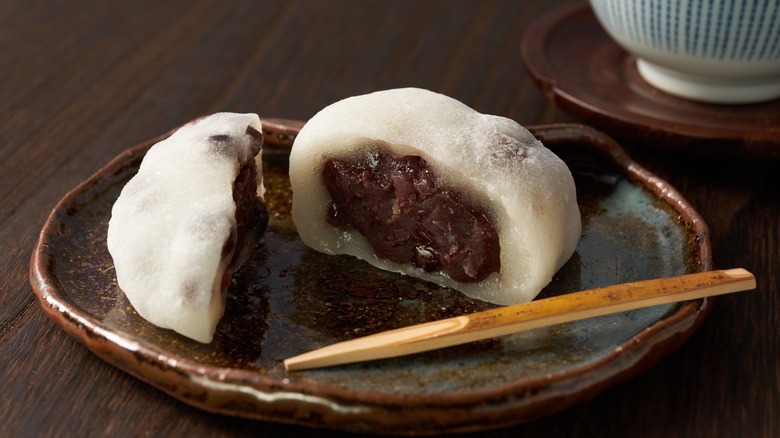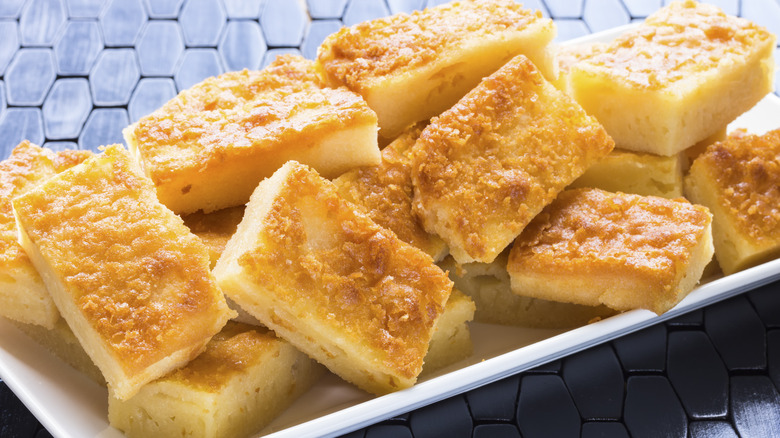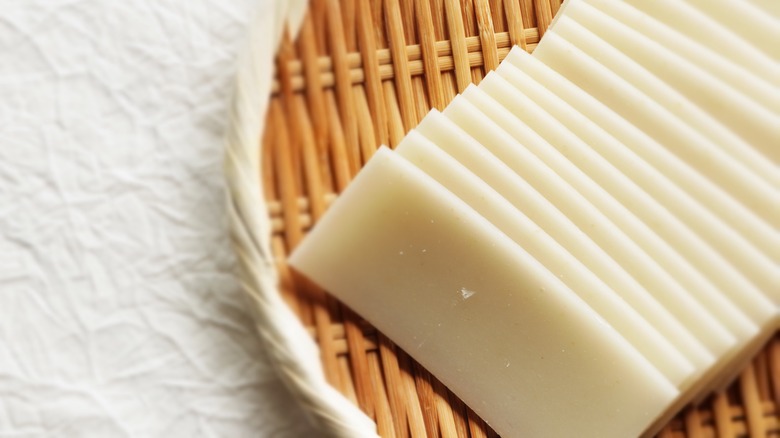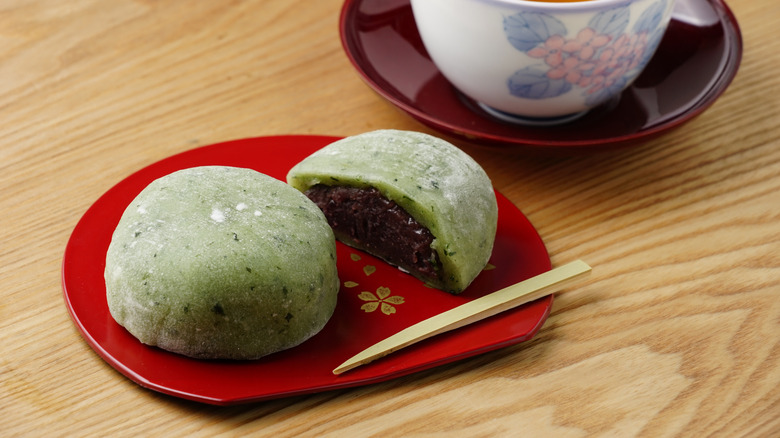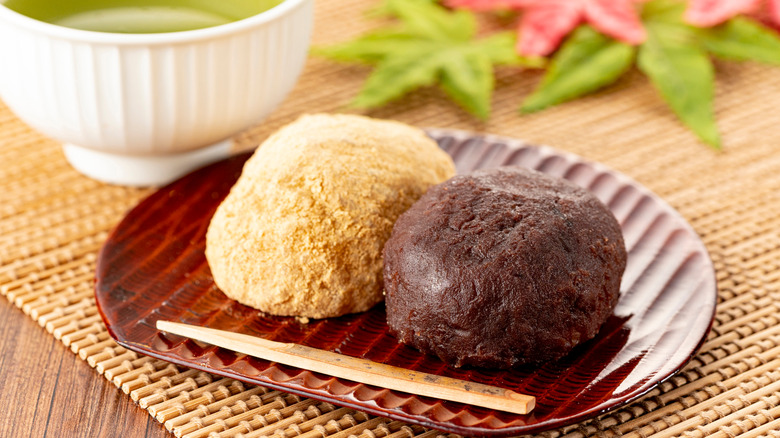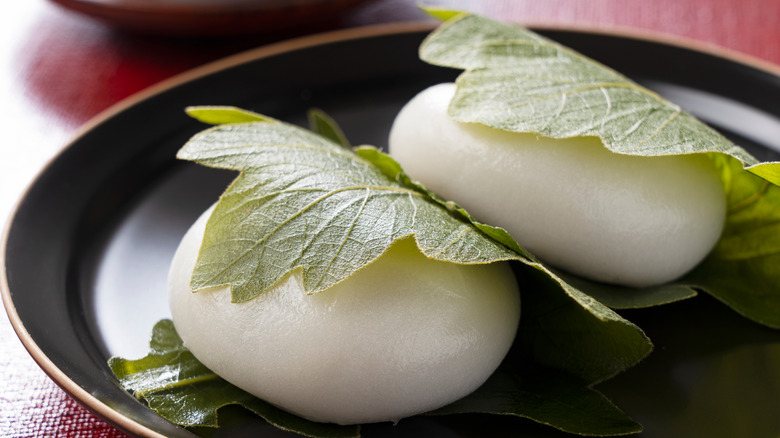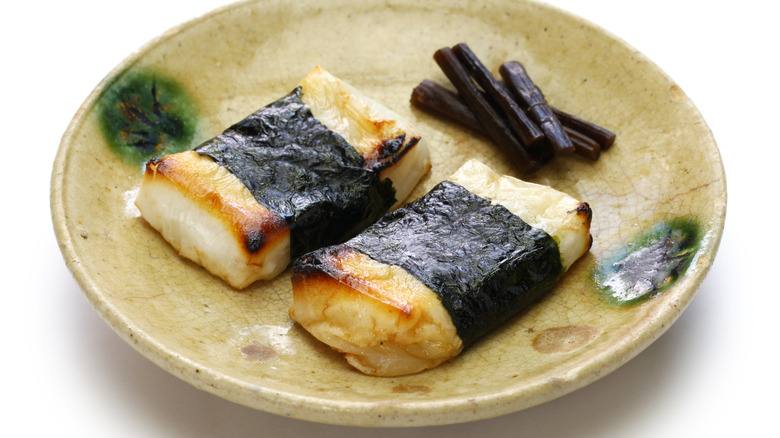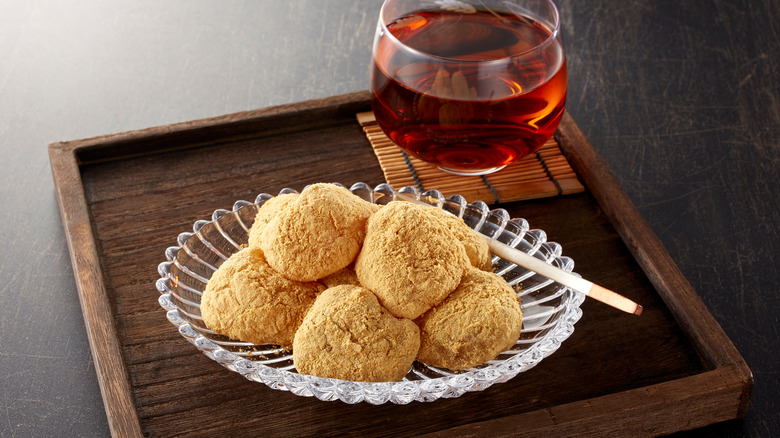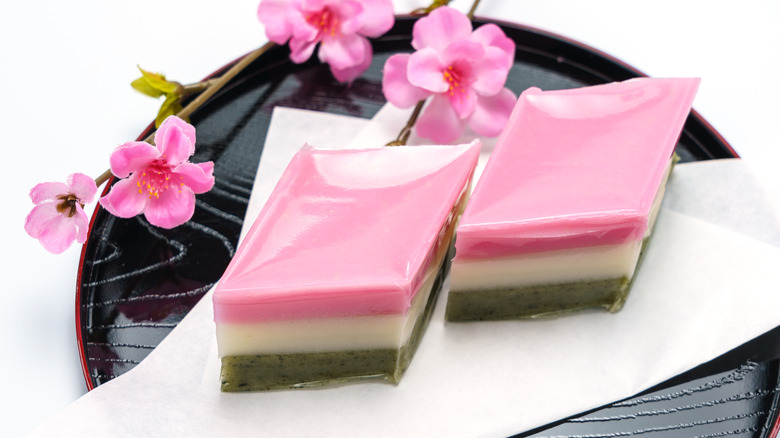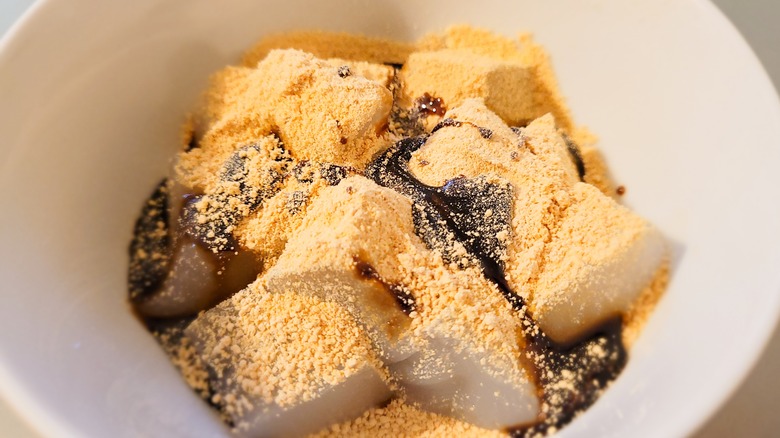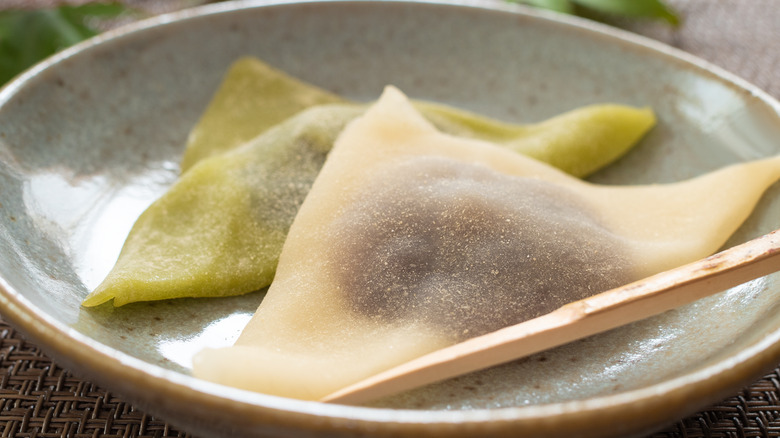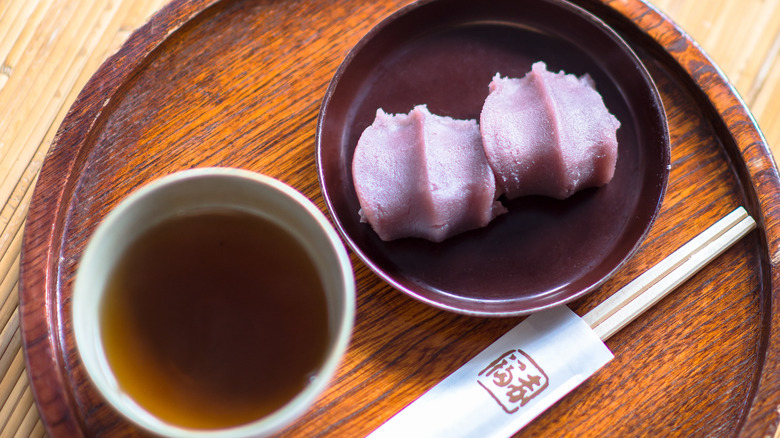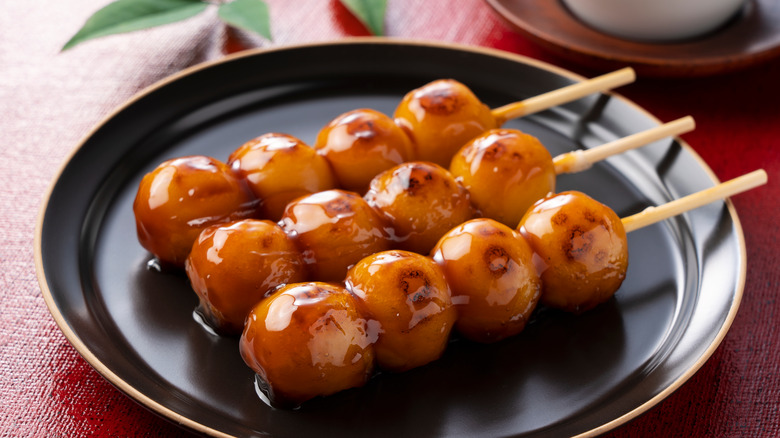16 Types Of Mochi, Explained
Originally made by pounding steamed glutinous rice called mochigome into a thick, chewy dough, mochi is a Japanese snack, confectionary, and iconic food item. Mochi today can be made in the traditional way, by pounding mochigome or from rice flour. According to Hungry Huy, there are two main types of rice flour: regular rice flour and glutinous rice flour. Regular rice flour is made from cooked rice that is then dehydrated and ground into flour. It is commonly used as a thickener like cornstarch or potato starch. On the other hand, glutinous rice flour is made from glutinous rice, also known as sticky rice. There are multiple varieties of sticky rice, but in general, it is no surprise that they all share the same characteristic of being sticky. This stickiness, when pounded into a paste, is what gives mochi its memorable chew. Glutinous rice flour can be used to make mochi without going through the intense process of pounding the cooked rice (via Live Japan)
Mochi is a very traditional food and confectionary across Japan, so much so that many types of mochi are integral to Japanese festivals and holidays. While the most well-known mochi across North America is arguably mochi ice cream, mochi comes in wide varieties full of texture, flavor, and culture. So the world can celebrate the diverse and delicious world of mochi, we have collected this wonderful list to get you excited about the marvelous world of mochi.
Kagami mochi
During the new year, it is common to see large and ornate alters all around Japan. You can find big or small displays in train stations, homes, and temples, each with a variety of offerings. One essential component of these alters is kagami mochi. Kagami mochi is a type of mochi specifically used to celebrate the new year and is also believed to bring good luck (via Honest Food Talks).
Kagami mochi always consists of three components. Two circular layers of hard mochi are stacked on top of one another, with a single mandarin orange perched on top. The mochi can be further adorned with other interesting items, such as ribbons, ferns, or other traditional new year decorations. Kagami mochi is usually eaten on a special day called Kagami Biraki, which generally falls on the 11th day of the new year and is considered a lucky day in Japanese culture.
Sakura mochi
This beautiful floral mochi is a harbinger of spring all over Japan. Few countries love cherry blossoms the way that Japan does, and this devotion is fully represented through the refined flavor and technique of sakura mochi. Sakura, meaning cherry blossom in Japanese, consists of mochi rice that is flavored with cherry blossom, filled with red bean paste, and wrapped in a salted cherry leaf (via Sudachi Recipes).
This beloved dessert comes in two major variations depending on which part of Japan you are in. In the Kansai region, sakura mochi takes on more of a dumpling-like shape and is stuffed with sweet red bean paste. In the Kanto region, the mochi is made from a mixture of regular rice flour and mochi flour before its rolled thin so that it can be wrapped around the bean paste, taking on a cannoli-like shape.
Kiri mochi
Kiri mochi is a very simple kind of mochi mostly available during the new year. According to Mochi Mommy, kiri mochi's simplicity is derived from the fact that it is made solely of mochi flour that has been cooked, pounded, and then pressed into either circles or rectangles. The mochi is then dried until it is incredibly hard, making it shelf-stable. Kiri mochi also has no sugar, which may surprise many mochi fans, making it great in both savory and sweet dishes. For example, in desserts like zenzai, a sweet red bean soup, kiri mochi is essential and brings a perfect chew to the otherwise soft beans.
At its core, kiri mochi is used mostly for new years ozoni. Ozoni, a traditional soup served as part of the Osechi new years meal, varies across Japan and from family to family. It can be enjoyed with a simple, clear dashi broth or have more components like miso, chicken, fish, or spinach. However, the one thing that can be agreed upon is that ozoni always has kiri mochi floating in it, ready to be chewed and enjoyed (via Mochi Mommy).
Daifuku
Daifuku mochi actually encompasses many types of mochi because daifuku refers to stuffed mochi in Japanese (via Japan Experience). Therefore, daifuku can be any mochi filled with something, whether that is the classic anko (sweet bean paste), strawberries, pineapple, or ume, you name it. That means that many of the mochi widely available today are actually considered daifuku, including the beloved mochi ice cream.
Daifuku are an important aspect of chadō, the Japanese sacred tea ceremony, and are also commonly eaten during the new year. Nonetheless, daifuku has gained such popularity that they are happily eaten all year round by many people across Japan and the world.
Butter mochi
Butter mochi is a beautiful example of mixing cultures. Hawaii, smack dab in the middle of the Pacific Ocean and a historical crossroad for East Asians and North Americans, is the birthplace of this irresistible take on mochi. Butter mochi, similar to mochi cake and muffins, is a dessert bar made from mochiko (mochi rice flour) and, among other ingredients, butter. This delectable combination comes together to create a chewy, sweet, and deliciously buttery dessert.
Butter mochi also shares many similarities with other types of mochi found in southern Japan and with desserts in the Philippines. In the Philippines, bibingka, a beloved Christmas dish made with rice flour and coconut cream, is familiarly chewy, sweet, and satisfying, just like its mochi cousin across the ocean.
Kaki mochi
Kaki mochi is actually very similar to kiri mochi but varies in shape and thickness. As per Food in Japan, kaki mochi is usually quite thin, unsweetened, and bite-sized, making it the perfect side dish for a meal or tea. Because the kaki mochi is unsweetened, it becomes quite hard once it is done drying, given that a high sugar content keeps mochi soft and chewy. Therefore, kaki mochi must be toasted, boiled, fried, or heated to re-soften it and ensure that it does not break any teeth! In Chiba, it is common to find fried or grilled kaki mochi as a snack accompanying tea. Alternatively, in Hokuriku, kaki mochi is dried on a stick and then thinly sliced before it is tied with straw or hemp and left to hang for one to two months.
Kaki mochi has since transformed from its traditional preparation and can now be found as kakimochi arare, which is known for its deliciousness as an every day, crunchy snack. What is the difference between the old and new versions? Crunchy kakimochi arare is a cracker similar to other arare, classic Japanese rice crackers that come in varying flavors, sizes, and shapes. Aside from kakimochi arare, kaki mochi also comes in varying shapes, flavors, and colors, depending on the region. This makes kaki mochi versatile and unique wherever you are in Japan.
Yomogi mochi
Yomogi mochi, like sakura mochi, is an iconic spring wagashi in Japan. Wagashi are traditional Japanese desserts, and yomogi mochi, also known as kusa mochi, certainly qualifies thanks to its long history and connection to Japanese culture. Yomogi is the word for mugwort, a pungent, bitter herb with many health benefits. Therefore, yomogi mochi refers to a type of mochi made by pounding yomogi into mochigome rice, making the resulting mochi green, grassy, and spring-like (via Yunomi).
Yomogi mochi can come in two main variations. One is a variety of daifuku called Yomogi daifuku, which is filled with anko (sweet bean paste), making the mochi a luxurious green color on the outside and purple from the beans inside. The other way to eat yomogi mochi is as a ball of pure mochi coated in kinako (roasted soybean flour). Kinako can be sweetened but is often either only mildly sweet or not sweet at all, allowing you to fully enjoy kinako's incredible nutty flavor. This means that the kinako version of yomogi mochi is certainly chewy and less sweet, considering the beans bring a lot of sweetness (via Japanese Products).
Botamochi
This variety, called botamochi in honor of the botan (peoney) that blooms in the spring, is very similar to another type of mochi called ohagi which is named after hagi (bush clover) and eaten in the autumn (via Just One Cookbook). Both ohagi and botamochi consit of anko filled with mochi. Therefore, botamochi is quite soft and sticky because the anko is on the outside. This design also adds to the deliciously soft and chewy texture of botamochi (via Kikoman).
Botamochi is made with glutinous rice that has been pounded until only half of the grains remain whole. This adds an element of texture to the mochi because, unlike other forms of mochi that are completely smooth, the remaining whole kernels bring more of a bite to the already chewy inside. Additionally, botamochi can come coated in either koshian paste (strained anko) or tsubuan (unstrained anko), which is chunkier and has pieces of bean remaining. Botamochi is also sometimes topped with sesame seeds or kinako (roasted soybean flour) (via Kikoman).
Kashiwa mochi
Kashiwa mochi, like sakura mochi, utilizes leaves in a very delicate and refined way. The leaves integral to kashiwa mochi come from oak trees, but not the oak trees with spiny leaves, the ones with large, lobed leaves. However, unlike sakura mochi, the oak leaves used in kashiwa mochi are not edible and are only used as decoration (via Just One Cookbook).
The oak leaves used for kashiwa mochi, traditionally eaten for Children's Day in Japan, represent prosperity because oak trees do not shed their leaves until it is time for new growth. While the leaves are not edible, their earthy aroma does transfer to the mochi, making the dessert lightly flavored. The mochi itself is either filled with filled with adzuki anko or miso anko, which is a sweet paste made from white beans and miso.
Isobe maki mochi
Isobe maki mochi, also known as isobeyaki mochi, is another type of savory mochi that uses dry, unsweetened rice cakes. According to Oishi Washoku, isobe means "rocky shore" in Japanese, where it is known that seaweed grows. Nowadays, isobe refers to foods wrapped in or cooked with seaweed, such as isobe maki mochi. Maybe you can now guess what isobe maki mochi consists of — mochi and seaweed.
To be more specific, isobe maki mochi is made with kiri mochi, wrapped in seaweed, and drizzled with soy sauce. The kiri mochi can be grilled, broiled, or boiled to soften them before being wrapped. Whatever your chosen cooking method is, make sure to enjoy this snack with soy sauce. The chewiness of the mochi combined with the salty soy sauce and seaweed is delicious.
Warabi mochi
Curiously named mochi, although not actually made from glutinous rice flour, warabi mochi is a common summer-time snack made from warabi starch. The harvesting and production of warabi starch are very time-consuming and labor-intensive because it must be harvested from the roots of the warabi plant (bracken starch), a fern-like bush that grows wild. Therefore, make sure to thoroughly enjoy warabi mochi if you ever get your hands on it (via Japanese Cooking 101).
Very jelly-like in consistency and almost fully translucent, warabi mochi certainly is a sight. Also commonly topped with kinako (roasted soybean flour), warabi mochi is a very alluring combination of the dry kinako and the cool, gelatinous warabi. Warabi mochi is not commonly made with a lot of sugar, if any, and therefore requires sweet toppings, so it is also often garnished with brown sugar syrup.
Hishi mochi
Hishi mochi is beautiful and symbolic. Traditionally eaten for Hinamatsuri (Girl's Day) in Japan, hishi mochi means rhombus or diamond mochi, derived from its diamond shape. Hishi mochi consists of three distinct layers, pink on top, followed by white, then green on the base. The colors red, white, and green symbolize health which every family wishes for (via Japan Center).
Hishi mochi is shaped like a diamond on purpose. The reason for this shape, in particular, is because diamonds traditionally represent fertility in Japanese culture. These diamond rice cakes are one of the essential items placed at the hinamatsuri altar that features dolls and other offerings (via Japan Center). Flavored with matcha in the green layer and delightfully chewy and dense, hishi mochi is not only culturally important, it is also delicious. Enjoy this treat with tea or just on its own, and make sure to savor the delicate layers.
Kuzu mochi
Kuzu mochi, like dango and warabi mochi, is another mochi impersonator that is not actually made from glutinous rice flour. Kuzu mochi is made from the starch of the kuzu or kudzu plant. Does that sound familiar? You may have heard of kudzu, not in the context of mochi, but because it is infamously invasive and destructive to buildings and landscapes. So good news – there is a way to eat it, and that is by making kuzu mochi.
Kuzu starch has unique characteristics that allow the final mochi to be jelly-like and almost translucent but without the starchy flavor that you get from other thickeners like arrowroot or cornstarch, as per Bokksu. To make this mochi, you simply cook sugar, water, and kuzu starch until the mixture has thickened and become transparent. Similar to warabi mochi, kuzu mochi is often enjoyed with kinako as an additional nutty surprise.
Yatsuhashi mochi
Yatsuhashi mochi's origin story is up for debate, but some theorize that this mochi dates back as far as the Edo period. So what makes this mochi so special and beloved? Traditionally lightly spiced with cinnamon and folded into a memorable triangle, yatsuhashi are an integral part of Kyoto's culture, making it one of the most sought-after omiage, or take-home gifts tourists purchase. While the iconic triangle-shaped yatsuhashi is commonly known today, Arigato Japan explains that in the past yatsuhashi were actually baked into distinct arches, allowing the sweet to stay good for a long time.
Today, yatsuhashi can be found most easily at traditional shops in Kyoto. This renowned type of mochi comes in various shapes, some filled and some not. Popular fillings include anko, sweet potato, brown sugar, and many others (via Arigato Japan). While it is easier to find the triangle-shaped yatsuhashi, if you look hard enough, you may even be able to find the original arch-shaped yatsuhashi.
Akafuku
Few mochi companies are as well known across Japan as Akafuku. This mochi, owned and made by the same family in the original shop for over 300 years, is a required stop for people on their way to the highly important Ise Jungu Shrine, located in the Mie prefecture. Akafuku mochi, inspired by the Isuzu river that flows right behind the shop, has three distinct arches of strained anko representing the river (via Akafuku). The anko sits atop a small ball of soft mochi, making this mochi a sort of reverse diafuku, like botan mochi.
Akafuku mochi has always been a staple snack or treat for travelers visiting the Ise Jingu Shrine. Visiting this shrine, which honors an important Shinto god, is a pilgrimage that many Japanese Shinto followers attempt to make in their lifetime. Therefore, Akafuku mochi is delicious, perfectly chewy, sweet, and deeply important to many Japanese people.
Dango
While in flavor and texture, dango may seem like mochi, it is actually just a mochi impersonator. Made with regular rice flour, not glutinous rice flour, dango do not necessarily fall under the mochi rice cake category but are so delightfully wonderful that we had to include them. This street snack, commonly topped with a sweet soy sauce glaze or found in the same colors as hishi mochi, red, and white, is a must-try non-mochi (via Yabai).
This snack is made by skewering small balls of rice flour on a bamboo stick and grilling them. The most common type of dango, Mitarashi dango, is named after the Kamo Mitarashi tea house in Kyoto, where dango was created. Today, you can find dango all over the world and definitely all across Japan. Whether there are three, four, or five dango balls on the skewers you encounter, if they are soft and topped with a shiny, sweet glaze, bets are that the dango will be divine.
